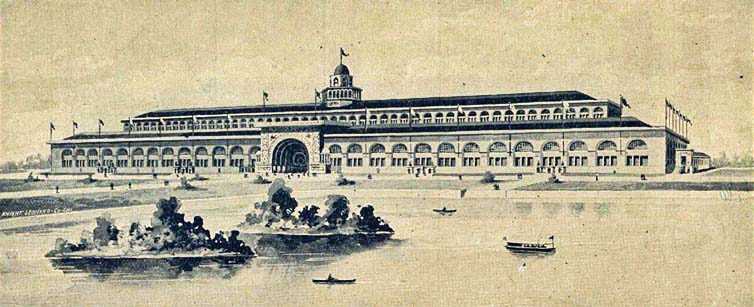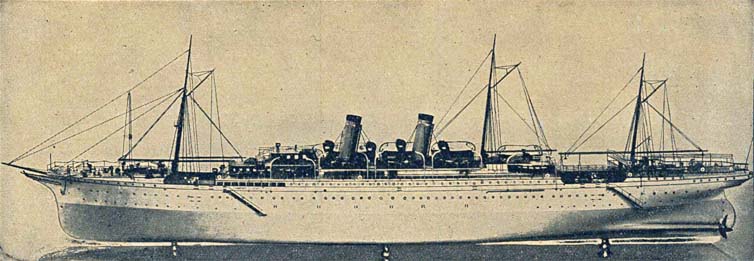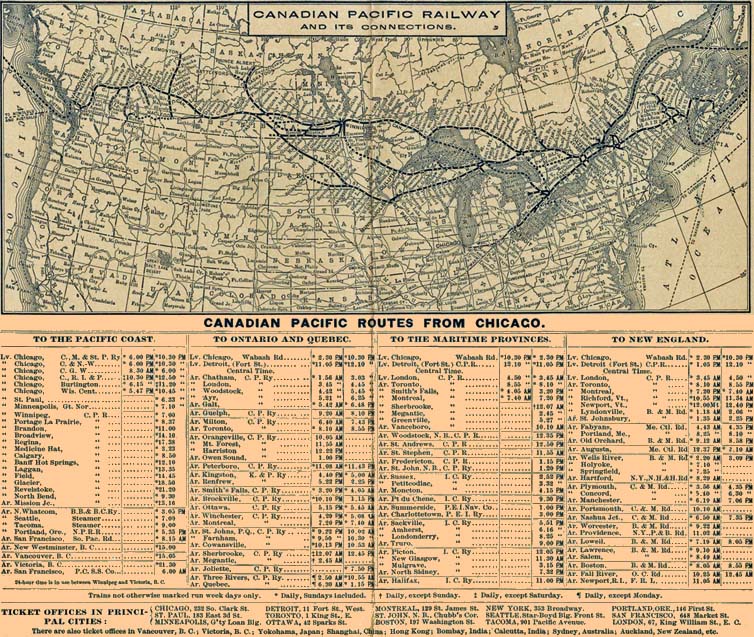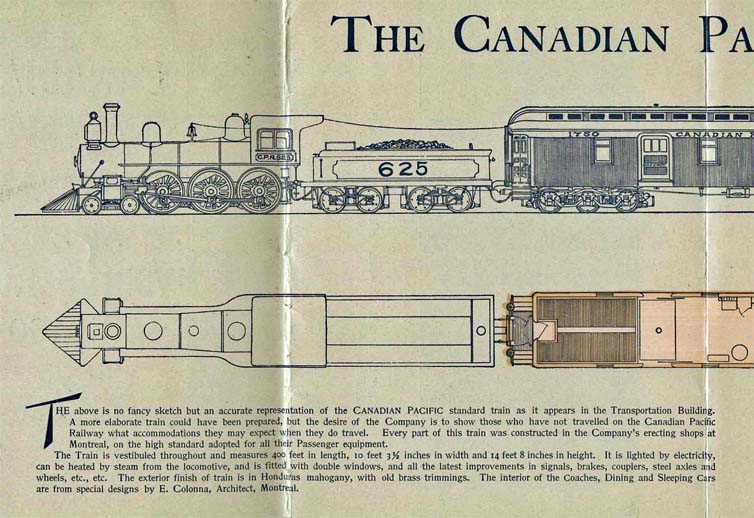 |  Pamphlet |


TRANSPORTATION BUILDING
COLUMBIA EXPOSITION
In which are displayed models of the Canadian Pacific Trans-Pacific Steamships, a Canadian Pacific Standard Passenger Train, and a collection of Oil Paintings of scenery on their Transcontinental Route.

The following is not intended to be a full description of the views of the CANADIAN PACIFIC scenery which appear on the overhead bridge in the center of the Transportation Building, but is more intended as a catalogue. These views are a few of a thousand, and give but a very imperfect idea of the many varied scenes which present themselves to passengers on the CANADIAN PACIFIC TRANSCONTINENTAL ROUTE. On the north side of the bridge, beginning at the left, we have:
 The links to photographs below on this page are NOT the original photos displayed at the 1883 Chicago World's Fair. They are mostly appropriate photographs from Library and Archives Canada.
The links to photographs below on this page are NOT the original photos displayed at the 1883 Chicago World's Fair. They are mostly appropriate photographs from Library and Archives Canada.Mount Stephen The monarch of the Canadian Rockies, towering over 8,000 feet above the track, which winds around the side of the mountain, high above the Kicking Horse River, into the valley of which Mount Stephen unburdens itself of the glacier which is ever resting on and obtruding beyond its shoulder. To the right is Field Peak, opposite Field Station, where one of the Company Chalet hotels affords accommodations for tourists.
The monarch of the Canadian Rockies, towering over 8,000 feet above the track, which winds around the side of the mountain, high above the Kicking Horse River, into the valley of which Mount Stephen unburdens itself of the glacier which is ever resting on and obtruding beyond its shoulder. To the right is Field Peak, opposite Field Station, where one of the Company Chalet hotels affords accommodations for tourists.
Hermit Range In the Selkirks, which lie immediately west of the Rockies, is as seen from near the Company's hotel at Glacier Station, within ten minutes' walk of the great glacier of the Selkirks. In the distance to the right is Hermit Mountain. The peak on the left is Mount Cheops, the slope on the right is the base of Sir Donald, the highest peak in the Selkirks. The slope to the left is that of Ross Peak.
In the Selkirks, which lie immediately west of the Rockies, is as seen from near the Company's hotel at Glacier Station, within ten minutes' walk of the great glacier of the Selkirks. In the distance to the right is Hermit Mountain. The peak on the left is Mount Cheops, the slope on the right is the base of Sir Donald, the highest peak in the Selkirks. The slope to the left is that of Ross Peak.
Mount Begbie In the Gold Range, or third west. This view of Begbie's snowy head is from the Selkirks across the valley of the Columbia. It is only one of the many stately peaks in the vicinity.
In the Gold Range, or third west. This view of Begbie's snowy head is from the Selkirks across the valley of the Columbia. It is only one of the many stately peaks in the vicinity.
Castle Mountain Affords many diversified pictures in the changing views that are presented as for ten miles the railway skirts its base. Hardly any other point on the journey has the same kaleidoscopic character, yet every view retains the idea of which the mountain owes its name. For one and all there is some suggestion of the donjon and the battlements of the ruined fortress.
Affords many diversified pictures in the changing views that are presented as for ten miles the railway skirts its base. Hardly any other point on the journey has the same kaleidoscopic character, yet every view retains the idea of which the mountain owes its name. For one and all there is some suggestion of the donjon and the battlements of the ruined fortress.
Lake Louise There are two views of this romantic sheet of water, one on each side of the bridge. The view as here presented is from the railway company's chalet, about one thousand feet above Laggan Station. The lake from west to east is about two miles in length, and the foot of the glacier, which looks as if it formed the eastern boundary, is really about four miles further east.
There are two views of this romantic sheet of water, one on each side of the bridge. The view as here presented is from the railway company's chalet, about one thousand feet above Laggan Station. The lake from west to east is about two miles in length, and the foot of the glacier, which looks as if it formed the eastern boundary, is really about four miles further east.
 Is here seen from the outlet of Lake Agnes, about 3,000 feet above the valley and line of the railway at Laggan Station. Mirror Lake, 1,000 feet below, is shown in the foreground, and 1,000 feet further down is Lake Louise. These "Lakes in the Clouds", Louise, Mirror, and Agnes, can be visited from Laggan Station with ease in from six to eight hours.
Is here seen from the outlet of Lake Agnes, about 3,000 feet above the valley and line of the railway at Laggan Station. Mirror Lake, 1,000 feet below, is shown in the foreground, and 1,000 feet further down is Lake Louise. These "Lakes in the Clouds", Louise, Mirror, and Agnes, can be visited from Laggan Station with ease in from six to eight hours.Mount Stephen Another view is here given of this stupendous mountain. The view shows Field Station, with its chalet hotel, at the base of the mountain, and in the distance, one of the most picturesque of the Rocky monsters, Cathedral Peak.
Another view is here given of this stupendous mountain. The view shows Field Station, with its chalet hotel, at the base of the mountain, and in the distance, one of the most picturesque of the Rocky monsters, Cathedral Peak.
The Three Sisters Canmore Are on the eastern slope of the Rockies, rising from the broad and beautiful valley of the Bow River. The three peaks afford a striking picture, and are seen to best advantage from the railway. On the south side of the overhead bridge there are:
Are on the eastern slope of the Rockies, rising from the broad and beautiful valley of the Bow River. The three peaks afford a striking picture, and are seen to best advantage from the railway. On the south side of the overhead bridge there are:
Ross Peak An imposing peak of the Selkirks which attracts the attention of all travellers who pass it. In the cleft to the left the railway circles around towards the Great Glacier, a magnificent view of which is to be found in the Canadian section of the Gallery of Fine Arts. Leaving the glacier, the line descends to the valley of the lllecillewaet by a series of loops
An imposing peak of the Selkirks which attracts the attention of all travellers who pass it. In the cleft to the left the railway circles around towards the Great Glacier, a magnificent view of which is to be found in the Canadian section of the Gallery of Fine Arts. Leaving the glacier, the line descends to the valley of the lllecillewaet by a series of loops at the foot of Ross Peak. To see this moun.tain and its surroundings, travellers should stop over at the Glacier House
at the foot of Ross Peak. To see this moun.tain and its surroundings, travellers should stop over at the Glacier House .
.
Mount Baker Is in the State of Washington, but is perhaps better seen from the CANADIAN PACIFIC RAILWAY on the bank of the Fraser River in British Columbia than from any other point. It is about sixty miles distant from the point of view, and towers about 14,000 feet above the river. Once seen, it is never forgotten.
Is in the State of Washington, but is perhaps better seen from the CANADIAN PACIFIC RAILWAY on the bank of the Fraser River in British Columbia than from any other point. It is about sixty miles distant from the point of view, and towers about 14,000 feet above the river. Once seen, it is never forgotten.
Cattle Ranching On the Bow River, Alberta. This scene is near Calgary, in the heart of the greatest ranching country on the continent. In the exhibit of the Canadian Government in the Agricultural Building may be seen two pictures representing horse and sheep ranching.
On the Bow River, Alberta. This scene is near Calgary, in the heart of the greatest ranching country on the continent. In the exhibit of the Canadian Government in the Agricultural Building may be seen two pictures representing horse and sheep ranching.
Farm Scene Near Brandon, Manitoba. Brandon is 130 miles west of Winnipeg in the great Canadian north-west wheat belt, and this scene is a fair representation of the whole of this vast prairie country.
Near Brandon, Manitoba. Brandon is 130 miles west of Winnipeg in the great Canadian north-west wheat belt, and this scene is a fair representation of the whole of this vast prairie country.
Banff The spacious building in the foreground is the famous Banff Hotel, in the immediate vicinity of some hot sulphur springs. The hotel is owned and operated by the CANADIAN PACIFIC RAILWAY COMPANY, and is open from May until October, inclusive. It is charmingly situated in the Canadian National Park, overlooking the valley of the Bow River. Immediately below the hotel the Spray joins the Bow with a rush over a series of tumultuous rapids. The sulphur range of mountains faces the hotel, and the peaks shown beyond to the right are those of Rundle Mountain. In the far distance is Inglismandie and to the left is Tunnel Mountain, round which the railway circles, and over which there are numerous carriage drives and bridle paths.
The spacious building in the foreground is the famous Banff Hotel, in the immediate vicinity of some hot sulphur springs. The hotel is owned and operated by the CANADIAN PACIFIC RAILWAY COMPANY, and is open from May until October, inclusive. It is charmingly situated in the Canadian National Park, overlooking the valley of the Bow River. Immediately below the hotel the Spray joins the Bow with a rush over a series of tumultuous rapids. The sulphur range of mountains faces the hotel, and the peaks shown beyond to the right are those of Rundle Mountain. In the far distance is Inglismandie and to the left is Tunnel Mountain, round which the railway circles, and over which there are numerous carriage drives and bridle paths.
The "Around the World Maps" On both sides of the overhead bridge, show the Northern Hemisphere, and the CANADIAN PACIFIC route around the world. At first sight the map may appear a little strange to those unaccustomed to see the world only on Mercator's distorted projection, but this is the only correct plan, and a glance will show how great a distance is saved by the CANADIAN PACIFIC route between Europe and Japan and other points in the Pacific. The study of our world on this map is made easy.
On both sides of the overhead bridge, show the Northern Hemisphere, and the CANADIAN PACIFIC route around the world. At first sight the map may appear a little strange to those unaccustomed to see the world only on Mercator's distorted projection, but this is the only correct plan, and a glance will show how great a distance is saved by the CANADIAN PACIFIC route between Europe and Japan and other points in the Pacific. The study of our world on this map is made easy.

The above is from a photograph of one of the models of the Canadian Pacific Railway Company's Trans-Pacific Steamships, which forms part of their exhibit in the Transportation Building.
The Canadian Pacific Trans-Pacific Fleet consists of the now famous Empress Steamships, the "Empress of India", "Empress of Japan", and "Empress of China". The following particulars of the Steamships may be of interest, 6,000 tons, lenght 485 feet, breadth 51 feet 2 inches, depth 36 feet 10 inches, twin screws, two sets triple-expansion engines, 10,000 horse power, speed 19 knots, cross and longitudinal water-tight bulkheads, double bottoms. They are fitted through-out with all modern improvements for speed, safety, and comfort.
VANCOUVER and VICTORIA B.C., YOKOHAMA, KOBE, and NAGASAKI JAPAN, SHANGHAI CHINA, and HONG KONG.
SAILINGS ARE THREE WEEKLY.
——— FAST MAIL RECORD ———
It was by the Steamship "Empress of Japan", the Canadian Pacific Railway, and the Steamship "City of New York", that the Royal Mails were carried from Yokohama, Japan, to London, England, in twenty-one days, a distance of 10,463 miles.

A JOURNEY Around the World not many years ago was considered the voyage of a lifetime, nowadays it is lightly under taken, and many people make the tour annually.
The CANADIAN PACIFIC RAILWAY COMPANY, by means of their unrivalled system of railway and their magnificent Empress Steamers on the Pacific, are enabled to offer this tour on very advantageous terms. Their trains, similar to that one on exhibition in the Transportation Building, and illustrated hereon, cross the American Continent from ocean to ocean, and their steamers, a model of which is similarly exhibited and illustrated, traverse the Pacific from British Columbia to Japan and China, connecting at Hong Kong with the well known Peninsular and Oriental steamers. By means of this connection the traveller proceeds on his journey via India and Egypt to London and Liverpool, where he takes one of the ocean greyhounds of the Atlantic. This tour round the world can be made for... $610.00 gold, or £125.
On June 14th, 1893, a new and superb steamship service to Australia and New Zealand, via Honolulu, was inaugurated. The trip occupies twenty-one days each way between Vancouver and Sydney.
Those who do not wish to go round the world, but desire to make the fashionable trip to the "Land of the Rising Sun", JAPAN, can proceed from Chicago to Yokohama for $259.50 and can procure a return ticket, good for four months, for $400, or good for twelve months for $450.
A less extended tour from Chicago to ALASKA can be made for $195, or a ticket from Chicago to THE PACIFIC COAST (Vancouver, Victoria, Seattle, Tacoma, or Portland), and return, for $100, with corresponding reduced rates from other points.
These rates may be reduced somewhat during the World's Fair.
For tickets, berth reservations, descriptive pamphlets, and all particu.lars, apply to 232 South Clark Street, Chicago, or at any other office of the CANADIAN PACIFIC RAILWAY.
Relating to the CANADIAN PACIFIC RAILWAY and its interests to be had on application at 232 South Clark Street, Chicago.
Westward to the Far East. (Illustrated.) By K. R. Scidmore. Descriptive of Japan and the principal cities in China and the route thereto.
Around the World. giving advices as to how that journey should be made, price, route, railways, etc.
Western Canada. Description of the vast wheat fields and ranching countries of Canada.
Timetable Folders. giving the complete train service of the longest railway in the world under one management.
Views of Scenery along the line of rail.way, in sets of 12, size 10 x 12 inches, in handsome portfolios, are on sale at all principal offices. Price, $1.50 Or, in rolls in sets of 3, size 22 x 28 inches, suitable for framing. Price, $1.00



